Giovanni Grasso (1873-1930) was an Italian stage and screen actor. While he was seen as the best Sicilian tragic actor and one of the best in Italy, he also had a limited but very important career in Italian silent cinema. Sadly, all of Grasso's films were considered lost, but in 2005 fortune smiled at us...
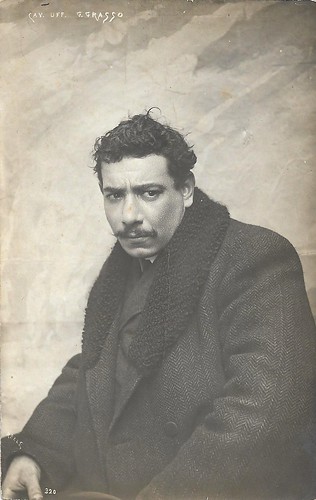
Italian postcard, no. 320. Photo: Photo Reale.
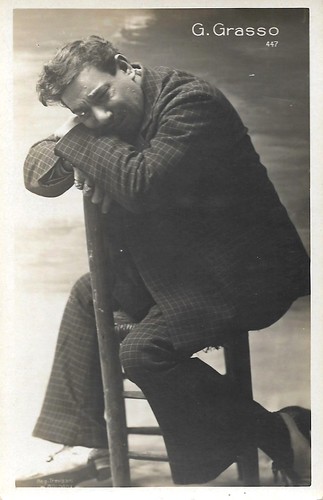
Italian postcard by Ed. Vettori, Bologna, no. 447.
Giovanni Grasso was born in Catania, Sicily, in 1873, as the son of puppet master Angelo Grasso and his second wife Ciccia (Francesca) Tudisco, who was a puppet master too. From Naples, Angelo Grasso’s father supposedly introduced the puppet theatre in Catania. Angelo opened a small puppet theatre in Catania, Teatro Machiavelli. After Angelo's death, his family turned it into a vaudeville theatre to survive. Small provincial companies stopped there, alternating edifying dramas with farces and subject performances ('scenoni'), inspired by news events. In this eclectic environment of the 1890s, young Giovanni Grasso was trained as a man of the stage. He decided to brush up on his paternal puppets, presenting – successful - shows. Among his greatest admirers was the playwright and journalist Nino Martoglio, who led the famous actor Ernesto Rossi to the Teatro Machiavelli. At the end of the show, Rossi, dazed by the expressive power of the puppeteer, urged him to become an actor.
This was the first of more 'revelation meetings' – with people like Gabriele D'Annunzio, Russian playwright Isaac Babel, and Russian stage director Vsevolod Meyerhold - that punctuated Grasso’s life, whose art was perhaps greater and, above all, more meaningful than he was aware of. At Rossi's requests, Grasso rearranged the auditorium and increasingly alternated written texts with crime scenes, thus beginning to define his own dramaturgical repertory that clung to Sicilian texts but was renewed by his interventions and his acting. Among his battle horses were 'I mafiusi di La Vicaria di Palermo' by Gaspare Mosca and Giuseppe Rizzotto, 'La zolfara' by Giuseppe Giusti Sinopoli, and 'Cavalleria rusticana' by Giovanni Verga. 'I mafiusi' (1863), was based on the stories of an authentic mafioso, a certain Gioacchino D'Angelo, just out of jail. The drama had an immediate and lasting success, especially when Grasso began to interpret it. 'La zolfara', based on the big upheaval of the strikes of the Sicilian miners, did not gain much recognition when it premiered in 1895, but thanks to Grasso’s version in dialect it became a triumph. Instead, 'Cavalleria rusticana', following Grasso’s often-used practice, was represented in the Sicilian translation of Martoglio.
In 1901 Grasso formed his own company Città di Catania, with Angelo Musco as ‘Brilliante’ and Carmelina Tria as the first actress (later replaced by Mimì Aguglia and after her by Marinella Bragaglia). He did his first world tour, starting at the Politeama in Salerno (with 'La zolfara'), on the initiative of the Capocomico (company manager) Mimì de Cesare, who sensed Grasso’s great talent. The tour subsequently touched Avellino and Naples, with good artistic success but bad economic results. The real consecration of Grasso, however, took place in Rome, where he was called for some charity performances organised for the victims of the Modica flood in 1902. Grasso made his debut at the Teatro dell'Argentina with 'Cavalleria rusticana' and 'I mafiusi' in 1901. When asked about Grasso, Martoglio answered: "His mirror is nature". This axiom, together with his powerful vigour, and instinctive to the limit of violence, remained the trademark of the actor and his company. His assistant, the Argentine Luigi Capuana, offered him the reworking in the dialect of his play 'Malia', while Grasso continued with resounding success in his performances in Rome at the Teatro Metastasio.
In Catania, the Macchiavelli burned down in 1903. The same year Martoglio wrote for Grasso a new text, 'Nica', and together with him he raised the first Sicilian dialectal drama company, which included Musco, Bragaglia, Lo Turco, Totò Majorana, Micio Grasso, and the families Spadaro and Balistrieri. Their repertory included, in addition to the dramas already mentioned, 'La lupa' and 'Caccia al lupo' by Giovanni Verga, 'San Giuvanni addicullatu' by Martoglio; and 'La festa di Adernò' by Grasso himself. After performances in Catania and Naples, the company set off for a new tour. While 'La zolfara' played without great success in Milan, Gabriele D'Annunzio, present, was struck by the expressive power. 'Nica' and 'Cavalleria rusticana' fared better, even if critics condemned the interventions in the latter.
After Milan, the tour continued touching Florence, Palermo, Messina and, again, Naples. Back in Catania in August 1903, Grasso had to accept another economic failure of the tour and dedicated himself to the reconstruction of the Teatro Machiavelli. Meanwhile, urged by V. Ferraù, administrator of the company, Martoglio gave life to the second Sicilian dialectal drama company. In 1904, this company set off for a new tour, ending in Turin. A novelty among the repertory became the hit of the season: 'A figghia di Joriu', Giuseppe Antonio Borgese’s Sicilian version of D'Annunzio's tragedy 'La figlia di Jorio' (The Daughter of Iorio), performed at the Teatro Costanzi in Rome in 1904.
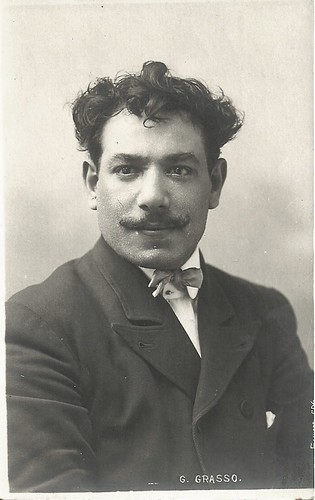
Italian postcard, no. 604. Photo: Sciutto.
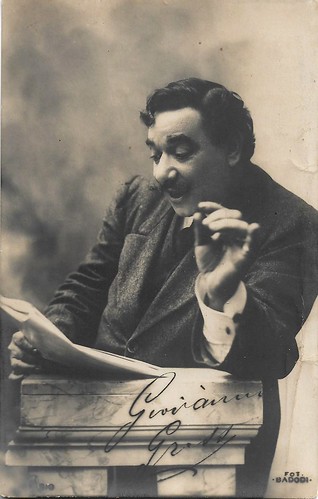
Italian postcard. Photo: Badodi, Milano, no. [510].
At the end of 1906, Giovanni Grasso's company departed for Spain, the initial stage of the long season of the big tours abroad, starting at the Novedades Theater in Barcelona. They continued in Portugal, and from there went to South America. After reprisals in Buenos Aires, the famous French actor A. Lugné-Poe, impresario of Eleonora Duse, hired the Sicilian actors for one of their most important international impacts: a tour in France. After their Parisian debut with 'Malia' at the Marigny Theater, critics wrote: "No convention, no tradition: nature, life". The realism of the actors was compared to that of the 'Japanese', the recitation was defined as "of an infinitely accurate and precise accuracy". Grasso’s repertory was classic: 'A figghia di Joriu', 'Cavalleria rusticana' and 'La morte civile' by Paolo Giacometti, already known to the Parisian public. Great appreciation was also obtained for 'La lupa', 'La zolfara', and 'Rusidda', by critics such as Catulle Mendès and by actors like Mounet-Sully. The usual appreciation for the 'naturalness' of acting was now joined by the recognition of the great technical expertise of Grasso and his companions. Giovanni Verga withdrew his texts for the changes made arbitrarily by Grasso. This also happened afterwards with Capuana and even with Martoglio.
Preceded by the echo of his French success, Giovanni Grasso debuted in London, again with 'Malia'. Here he saw the excellent criticisms repeated that praised his realism as "amazing, fulminant, colossal" and, again, his great acting technique. In October the company made its debut in Berlin. After a fleeting episode in Hungary, the company moved to Russia, at the time one of the most vital centres of the European theatre. The debut was in St. Petersburg, with 'Malia', 'Stone between stones' by Hermann Sudermann, 'The zolfara', 'A figghia di Joriu' and 'Feudalism'. This was a Sicilian version by A. Campagna of 'Terra baixa' (Lowlands), by Angel Guimerà and another pillar of the repertoire of Grasso after his South American tour. Subsequent shows were given in Moscow and Odessa, both very important for the construction of the 'fame' of Grasso and for the definition of his artistic figure. In Moscow, personalities of the calibre of the innovating actor-director Konstantin Stanislavski, author Vladimir Nemirovich-Danchenko and designer and director Edward Gordon Craig attended his shows, while Grasso, at the height of his success, was received at court. In Odessa, he saw a fourteen-year-old Isaac Babel, who would later write on it in one of his 'Stories of Odessa' (1931). In Babel's stunned words, Grasso’s performance in 'Feudalism', already famous, exploded to theoretical attention, the famous anecdote for how the pastor, played by Grasso, kills his rival by biting him in the throat, after having literally 'flown' across the whole scene.
In this respect, Vsevolod Meyerhold wrote: "I realised numerous laws of the biomechanics when I saw the acting of the magnificent Sicilian tragic actor Grasso". By identifying the biomechanical roots in the movement of the whole body, regardless of the part directly affected, Meyerhold was the first in succeeding to clarify that 'expressive power', which many had only intuitively perceived. With Grasso it was always the whole body that acted, spoke, or simply, was present, that is: to be perceived, on stage. In 1909, after the Russian tour, the company returned to England. Particularly significant, this time, was Grasso’s interpretation of 'Othello', one of his earliest roles but one he had always refused to represent outside of his Catania. The success was, as usual, amazing, while critics spoke now openly of self-restraint, while for 'Feudalism', they defined Grasso 'a physical obsession', but a controlled obsession guided by technique.
In 1910, the company embarked on a second eight-month tour to South America, touching Argentina, Chile, Brazil and Peru. Back in Catania, after a new stop in England, Grasso married singer Concetta Silvia Carducci, with whom he had lived from the times of the Machiavelli variety, and with whom he had four children. He then dissolved the company for a long period of rest. More or less since this time Grasso, now in a declining phase, threw off his theatrical activity, although never interrupted even if the repertoire was enriched with new texts, including 'Il berretto a sonagli' by Luigi Pirandello. In 1913 he played 'Cavalleria rusticana' in Rome; in 1916 he was in Messina; in 1917 in Palermo and in 1919 in Rome, at the Teatro Eliseo.
In 1921, Grasso left for a tour in the United States with Carolina Balistrieri Bragaglia as the first actress. They debuted in New York with 'Feudalism', at the Major Royal Theatre, in the heart of the Italian quarter. The performances lasted for five months, with traditional battle horses like 'Malia' and 'Cavalleria rusticana', but also with novelties by young authors. Success continued to be great, but at the end of this tour, Grasso's voice showed the first signs of hoarseness worsened over time. In 1923, he formed a new company with his brother Micio, his cousin Giovanni Junior (who eventually would become a famous sound film actor too), and Virginia Balistrieri, Junior’s wife. In 1927-1928 Grasso did his last tour in America. In his last years, with a by now almost extinct voice, he gradually lost the public’s favour.
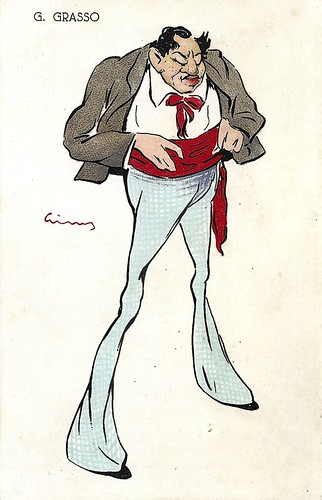
Italian postcard by CCM (Cesare Capello, Milano). Caricature by Girus (Giuseppe Russo, 1888-1960).

Italian postcard by G.B. Falci, Roma. Giovanni Grasso as Alfio and Tina Xeo as Santuzza in the Italian silent film Cavalleria rusticana (Mario Gargiulo, 1924), based on Giovanni Verga's text.
Giovanni Grasso was also a popular cinema actor. Already in 1910, during his second South American tour, he had shot two films based on his stage successes: La morte civile/Muerte civil (1910) and Cavalleria rusticana (1910). The two films were directed by Mario Gallo. But, as usual, Martoglio offered him the most significant occasions. At the end of 1913, Martoglio had been appointed artistic director of the Rome-based company Morgana Films. Morgana produced the trilogy Capitan Blanco (Nino Martoglio, Roberto Danesi, 1914), starring Grasso and Virginia Balestrieri, Sperduti nel bui/Lost in the Dark (Nino Martoglio, 1914), with Grasso, Balestrieri and Maria Carmi; and Teresa Raquin (Nino Martoglio, 1914) with Maria Carmi and Dillo Lombardo but without Grasso. The latter was based on Émile Zola’s famous novel.
Sperduti nel bui/Lost in the Dark is Grasso’s most famous film and was considered almost an incunabulum of pre-Neorealist cinema. Grasso interpreted the blind Nunzio. In a review, Bracco underlined the "expressive" contrast between the grace of the character and the power of the actor. In the early 1940s, Sperduti nel buio was hailed as a precursor of what would become Italian Neorealism, but during the war, the Germans took the print from the Roman archive. It never resurfaced; neither did other prints of the film. This raised the film's mythology. The cinematographic activity of Grasso continued until 1926. Between 1919 and 1926, he was very active and performed in some nine films, including Mala Pasqua (Ignazio Lupi, 1919) with Linda Pini, L'ospite sconosciuta/The Unknown Guest (Telemaco Ruggeri, 1923) with Pina Menichelli, and Cavalleria rusticana (Mario Gargiulo, 1924) with Grasso as Alfio, Mary Cléo Tarlarini as Nunzia, Tina Xeo as Santuzza and Livio Pavanelli as Turiddu.
Twice Grasso had the lead in the Balzac adaptations Vautrin (Alexandre Davrennes, 1919) and Tromp-la-Mort (Devarennes, 1920). Amleto Palermi directed Grasso in three films: Dopo il peccato (1920) with Bella Starace Sainati, Il dramma dell’amore (1920) with Claretta Sabatelli, and La casa degli scapoli (1923) with Diomira Jacobini and Livio Pavanelli. Grosso had his last film part in the Capuana adaptation Il cavalier Petagna (Mario Gargiulo, 1926), with Soava Gallone. Giovanni Grasso died in Catania in 1930. He was 56.
Unfortunately, almost all of Giovanni Grasso's films have been lost. With particular reference to Sperduti nel buio, one of the most sought-after films in the world of film archives and film history, we can only talk about it based on the screenplay, photos and reviews. A booklet with 24 photos has been put online on the website Portale Cinema Muto Italiano. But sometimes fortune smiles at us. In 2005, at the Dutch EYE Filmmuseum, a tinted print of the short Cines film Un amore selvaggio (director unknown, 1912) was found, restored and relaunched internationally. Un amore selvaggio is a rural drama, clearly influenced by the literary works of Verga and Capuana. On a Sicilian farm, brother Giuseppe and sister Carmela work both. The rebel and violent Giuseppe is fired for offending his master and would like to take his sister with him, but she refuses because she desperately loves the owner’s son Alessandro (Grasso). Alessandro rejects her while he is already engaged. Carmela then tries to poison her rival in love, but she is discovered and in turn, cast out. To take revenge, she tells Giuseppe that she has been seduced by Alessandro and asks her brother to kill him. But while she spies on her rival's house, she rolls into an embankment and is cared for by Alexander's good and kind girlfriend. Repentant, Carmela confesses to Giuseppe she lied, just as he is about to hit Alessandro with a sickle. He forgives her and the two leave together.
But who were the Southern Italian actors in Un amore selvaggio? In 1912, Cines shot three films with the famous southern actor Raffaele Viviani and his sister Luisella Viviani. These were known as their only film roles. Cines had also filmed two famous plays with Giovanni Grasso, 'Malia' and 'Feudalismo'. However, film historians Aldo Bernardini and Vittorio Martinelli did not connect him to Un amore selvaggio in their famous filmography 'Il cinema muto italiano'). In 2011, Un amore selvaggio was shown in Sicily before the heirs of Giovanni Grasso and Raffaele Viviani’s son. They immediately recognised the actors. Raffaele Viviani played Giovanni, his sister Luisella Viviani played Carmela and Grasso played Alessandro. This is remarkable as the brutal and tragic character of Giuseppe reminds of Grasso’s expressive parts, while here Viviani plays that part and Grasso has a more moderate role. Anyway, Un amore selvaggio (1912) is the only surviving film with Raffaele and Luisella Viviani, but also the only surviving film with Giovanni Grasso.

Italian postcard by G.B. Falci, Milano. Pina Menichelli and Giovanni Grasso in Malafemmina .
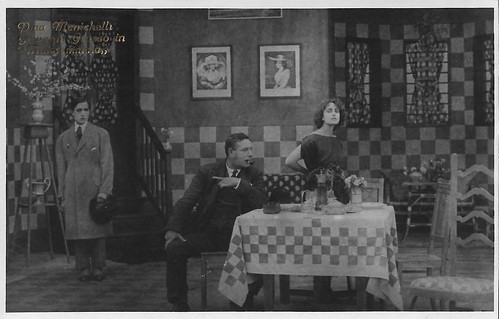
Italian postcard by G.B. Falci, Milano. Pina Menichelli and Giovanni Grasso in Malafemmina.
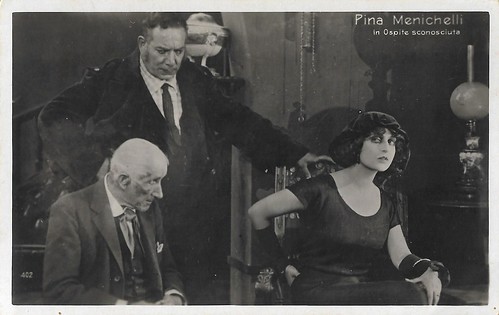
Italian postcard by Vettori, Bologna, no. 402. Pina Menichelli and Giovanni Grasso in Malafemmina.
Malafemmina is a film unknown to IMDb, but it was the alternative title of L'ospite sconosciuta/The Unknown Guest (Telemaco Ruggeri, 1923). The plot written by future director Amleto Palermi deals with Pietro, a young provincial (Andrea Conigliaro) who falls into the clutches of Stasia, a mundane adventuress (Menichelli) and spends his father's money on her. Di Scenta, the father (Grasso), pushes the woman to convince the son she never loved him and enforces this by having his son discover the two of them in a restaurant. The son shoots the woman, while the father takes the blame. The Italian censor didn't allow the representation nor even the suggestion that the son thinks he has to compete with his father in his love for Stasia. So all the scenes in which the father pretends his love for the woman to save his son were cut, as well as the intertitles explaining this situation. The film became incomprehensible and Italian critics therefore didn't like it.
Sources: Franco Ruffini (Dizionario Biografico degli Italiani, Volume 58 2002 - Italian), Ipercultura (Italian - now defunct), Wikipedia (Italian) and IMDb.
This post was last updated on 8 July 2024.

Italian postcard, no. 320. Photo: Photo Reale.

Italian postcard by Ed. Vettori, Bologna, no. 447.
Nature as a mirror
Giovanni Grasso was born in Catania, Sicily, in 1873, as the son of puppet master Angelo Grasso and his second wife Ciccia (Francesca) Tudisco, who was a puppet master too. From Naples, Angelo Grasso’s father supposedly introduced the puppet theatre in Catania. Angelo opened a small puppet theatre in Catania, Teatro Machiavelli. After Angelo's death, his family turned it into a vaudeville theatre to survive. Small provincial companies stopped there, alternating edifying dramas with farces and subject performances ('scenoni'), inspired by news events. In this eclectic environment of the 1890s, young Giovanni Grasso was trained as a man of the stage. He decided to brush up on his paternal puppets, presenting – successful - shows. Among his greatest admirers was the playwright and journalist Nino Martoglio, who led the famous actor Ernesto Rossi to the Teatro Machiavelli. At the end of the show, Rossi, dazed by the expressive power of the puppeteer, urged him to become an actor.
This was the first of more 'revelation meetings' – with people like Gabriele D'Annunzio, Russian playwright Isaac Babel, and Russian stage director Vsevolod Meyerhold - that punctuated Grasso’s life, whose art was perhaps greater and, above all, more meaningful than he was aware of. At Rossi's requests, Grasso rearranged the auditorium and increasingly alternated written texts with crime scenes, thus beginning to define his own dramaturgical repertory that clung to Sicilian texts but was renewed by his interventions and his acting. Among his battle horses were 'I mafiusi di La Vicaria di Palermo' by Gaspare Mosca and Giuseppe Rizzotto, 'La zolfara' by Giuseppe Giusti Sinopoli, and 'Cavalleria rusticana' by Giovanni Verga. 'I mafiusi' (1863), was based on the stories of an authentic mafioso, a certain Gioacchino D'Angelo, just out of jail. The drama had an immediate and lasting success, especially when Grasso began to interpret it. 'La zolfara', based on the big upheaval of the strikes of the Sicilian miners, did not gain much recognition when it premiered in 1895, but thanks to Grasso’s version in dialect it became a triumph. Instead, 'Cavalleria rusticana', following Grasso’s often-used practice, was represented in the Sicilian translation of Martoglio.
In 1901 Grasso formed his own company Città di Catania, with Angelo Musco as ‘Brilliante’ and Carmelina Tria as the first actress (later replaced by Mimì Aguglia and after her by Marinella Bragaglia). He did his first world tour, starting at the Politeama in Salerno (with 'La zolfara'), on the initiative of the Capocomico (company manager) Mimì de Cesare, who sensed Grasso’s great talent. The tour subsequently touched Avellino and Naples, with good artistic success but bad economic results. The real consecration of Grasso, however, took place in Rome, where he was called for some charity performances organised for the victims of the Modica flood in 1902. Grasso made his debut at the Teatro dell'Argentina with 'Cavalleria rusticana' and 'I mafiusi' in 1901. When asked about Grasso, Martoglio answered: "His mirror is nature". This axiom, together with his powerful vigour, and instinctive to the limit of violence, remained the trademark of the actor and his company. His assistant, the Argentine Luigi Capuana, offered him the reworking in the dialect of his play 'Malia', while Grasso continued with resounding success in his performances in Rome at the Teatro Metastasio.
In Catania, the Macchiavelli burned down in 1903. The same year Martoglio wrote for Grasso a new text, 'Nica', and together with him he raised the first Sicilian dialectal drama company, which included Musco, Bragaglia, Lo Turco, Totò Majorana, Micio Grasso, and the families Spadaro and Balistrieri. Their repertory included, in addition to the dramas already mentioned, 'La lupa' and 'Caccia al lupo' by Giovanni Verga, 'San Giuvanni addicullatu' by Martoglio; and 'La festa di Adernò' by Grasso himself. After performances in Catania and Naples, the company set off for a new tour. While 'La zolfara' played without great success in Milan, Gabriele D'Annunzio, present, was struck by the expressive power. 'Nica' and 'Cavalleria rusticana' fared better, even if critics condemned the interventions in the latter.
After Milan, the tour continued touching Florence, Palermo, Messina and, again, Naples. Back in Catania in August 1903, Grasso had to accept another economic failure of the tour and dedicated himself to the reconstruction of the Teatro Machiavelli. Meanwhile, urged by V. Ferraù, administrator of the company, Martoglio gave life to the second Sicilian dialectal drama company. In 1904, this company set off for a new tour, ending in Turin. A novelty among the repertory became the hit of the season: 'A figghia di Joriu', Giuseppe Antonio Borgese’s Sicilian version of D'Annunzio's tragedy 'La figlia di Jorio' (The Daughter of Iorio), performed at the Teatro Costanzi in Rome in 1904.

Italian postcard, no. 604. Photo: Sciutto.

Italian postcard. Photo: Badodi, Milano, no. [510].
A physical obsession
At the end of 1906, Giovanni Grasso's company departed for Spain, the initial stage of the long season of the big tours abroad, starting at the Novedades Theater in Barcelona. They continued in Portugal, and from there went to South America. After reprisals in Buenos Aires, the famous French actor A. Lugné-Poe, impresario of Eleonora Duse, hired the Sicilian actors for one of their most important international impacts: a tour in France. After their Parisian debut with 'Malia' at the Marigny Theater, critics wrote: "No convention, no tradition: nature, life". The realism of the actors was compared to that of the 'Japanese', the recitation was defined as "of an infinitely accurate and precise accuracy". Grasso’s repertory was classic: 'A figghia di Joriu', 'Cavalleria rusticana' and 'La morte civile' by Paolo Giacometti, already known to the Parisian public. Great appreciation was also obtained for 'La lupa', 'La zolfara', and 'Rusidda', by critics such as Catulle Mendès and by actors like Mounet-Sully. The usual appreciation for the 'naturalness' of acting was now joined by the recognition of the great technical expertise of Grasso and his companions. Giovanni Verga withdrew his texts for the changes made arbitrarily by Grasso. This also happened afterwards with Capuana and even with Martoglio.
Preceded by the echo of his French success, Giovanni Grasso debuted in London, again with 'Malia'. Here he saw the excellent criticisms repeated that praised his realism as "amazing, fulminant, colossal" and, again, his great acting technique. In October the company made its debut in Berlin. After a fleeting episode in Hungary, the company moved to Russia, at the time one of the most vital centres of the European theatre. The debut was in St. Petersburg, with 'Malia', 'Stone between stones' by Hermann Sudermann, 'The zolfara', 'A figghia di Joriu' and 'Feudalism'. This was a Sicilian version by A. Campagna of 'Terra baixa' (Lowlands), by Angel Guimerà and another pillar of the repertoire of Grasso after his South American tour. Subsequent shows were given in Moscow and Odessa, both very important for the construction of the 'fame' of Grasso and for the definition of his artistic figure. In Moscow, personalities of the calibre of the innovating actor-director Konstantin Stanislavski, author Vladimir Nemirovich-Danchenko and designer and director Edward Gordon Craig attended his shows, while Grasso, at the height of his success, was received at court. In Odessa, he saw a fourteen-year-old Isaac Babel, who would later write on it in one of his 'Stories of Odessa' (1931). In Babel's stunned words, Grasso’s performance in 'Feudalism', already famous, exploded to theoretical attention, the famous anecdote for how the pastor, played by Grasso, kills his rival by biting him in the throat, after having literally 'flown' across the whole scene.
In this respect, Vsevolod Meyerhold wrote: "I realised numerous laws of the biomechanics when I saw the acting of the magnificent Sicilian tragic actor Grasso". By identifying the biomechanical roots in the movement of the whole body, regardless of the part directly affected, Meyerhold was the first in succeeding to clarify that 'expressive power', which many had only intuitively perceived. With Grasso it was always the whole body that acted, spoke, or simply, was present, that is: to be perceived, on stage. In 1909, after the Russian tour, the company returned to England. Particularly significant, this time, was Grasso’s interpretation of 'Othello', one of his earliest roles but one he had always refused to represent outside of his Catania. The success was, as usual, amazing, while critics spoke now openly of self-restraint, while for 'Feudalism', they defined Grasso 'a physical obsession', but a controlled obsession guided by technique.
In 1910, the company embarked on a second eight-month tour to South America, touching Argentina, Chile, Brazil and Peru. Back in Catania, after a new stop in England, Grasso married singer Concetta Silvia Carducci, with whom he had lived from the times of the Machiavelli variety, and with whom he had four children. He then dissolved the company for a long period of rest. More or less since this time Grasso, now in a declining phase, threw off his theatrical activity, although never interrupted even if the repertoire was enriched with new texts, including 'Il berretto a sonagli' by Luigi Pirandello. In 1913 he played 'Cavalleria rusticana' in Rome; in 1916 he was in Messina; in 1917 in Palermo and in 1919 in Rome, at the Teatro Eliseo.
In 1921, Grasso left for a tour in the United States with Carolina Balistrieri Bragaglia as the first actress. They debuted in New York with 'Feudalism', at the Major Royal Theatre, in the heart of the Italian quarter. The performances lasted for five months, with traditional battle horses like 'Malia' and 'Cavalleria rusticana', but also with novelties by young authors. Success continued to be great, but at the end of this tour, Grasso's voice showed the first signs of hoarseness worsened over time. In 1923, he formed a new company with his brother Micio, his cousin Giovanni Junior (who eventually would become a famous sound film actor too), and Virginia Balistrieri, Junior’s wife. In 1927-1928 Grasso did his last tour in America. In his last years, with a by now almost extinct voice, he gradually lost the public’s favour.

Italian postcard by CCM (Cesare Capello, Milano). Caricature by Girus (Giuseppe Russo, 1888-1960).

Italian postcard by G.B. Falci, Roma. Giovanni Grasso as Alfio and Tina Xeo as Santuzza in the Italian silent film Cavalleria rusticana (Mario Gargiulo, 1924), based on Giovanni Verga's text.
The only surviving film
Giovanni Grasso was also a popular cinema actor. Already in 1910, during his second South American tour, he had shot two films based on his stage successes: La morte civile/Muerte civil (1910) and Cavalleria rusticana (1910). The two films were directed by Mario Gallo. But, as usual, Martoglio offered him the most significant occasions. At the end of 1913, Martoglio had been appointed artistic director of the Rome-based company Morgana Films. Morgana produced the trilogy Capitan Blanco (Nino Martoglio, Roberto Danesi, 1914), starring Grasso and Virginia Balestrieri, Sperduti nel bui/Lost in the Dark (Nino Martoglio, 1914), with Grasso, Balestrieri and Maria Carmi; and Teresa Raquin (Nino Martoglio, 1914) with Maria Carmi and Dillo Lombardo but without Grasso. The latter was based on Émile Zola’s famous novel.
Sperduti nel bui/Lost in the Dark is Grasso’s most famous film and was considered almost an incunabulum of pre-Neorealist cinema. Grasso interpreted the blind Nunzio. In a review, Bracco underlined the "expressive" contrast between the grace of the character and the power of the actor. In the early 1940s, Sperduti nel buio was hailed as a precursor of what would become Italian Neorealism, but during the war, the Germans took the print from the Roman archive. It never resurfaced; neither did other prints of the film. This raised the film's mythology. The cinematographic activity of Grasso continued until 1926. Between 1919 and 1926, he was very active and performed in some nine films, including Mala Pasqua (Ignazio Lupi, 1919) with Linda Pini, L'ospite sconosciuta/The Unknown Guest (Telemaco Ruggeri, 1923) with Pina Menichelli, and Cavalleria rusticana (Mario Gargiulo, 1924) with Grasso as Alfio, Mary Cléo Tarlarini as Nunzia, Tina Xeo as Santuzza and Livio Pavanelli as Turiddu.
Twice Grasso had the lead in the Balzac adaptations Vautrin (Alexandre Davrennes, 1919) and Tromp-la-Mort (Devarennes, 1920). Amleto Palermi directed Grasso in three films: Dopo il peccato (1920) with Bella Starace Sainati, Il dramma dell’amore (1920) with Claretta Sabatelli, and La casa degli scapoli (1923) with Diomira Jacobini and Livio Pavanelli. Grosso had his last film part in the Capuana adaptation Il cavalier Petagna (Mario Gargiulo, 1926), with Soava Gallone. Giovanni Grasso died in Catania in 1930. He was 56.
Unfortunately, almost all of Giovanni Grasso's films have been lost. With particular reference to Sperduti nel buio, one of the most sought-after films in the world of film archives and film history, we can only talk about it based on the screenplay, photos and reviews. A booklet with 24 photos has been put online on the website Portale Cinema Muto Italiano. But sometimes fortune smiles at us. In 2005, at the Dutch EYE Filmmuseum, a tinted print of the short Cines film Un amore selvaggio (director unknown, 1912) was found, restored and relaunched internationally. Un amore selvaggio is a rural drama, clearly influenced by the literary works of Verga and Capuana. On a Sicilian farm, brother Giuseppe and sister Carmela work both. The rebel and violent Giuseppe is fired for offending his master and would like to take his sister with him, but she refuses because she desperately loves the owner’s son Alessandro (Grasso). Alessandro rejects her while he is already engaged. Carmela then tries to poison her rival in love, but she is discovered and in turn, cast out. To take revenge, she tells Giuseppe that she has been seduced by Alessandro and asks her brother to kill him. But while she spies on her rival's house, she rolls into an embankment and is cared for by Alexander's good and kind girlfriend. Repentant, Carmela confesses to Giuseppe she lied, just as he is about to hit Alessandro with a sickle. He forgives her and the two leave together.
But who were the Southern Italian actors in Un amore selvaggio? In 1912, Cines shot three films with the famous southern actor Raffaele Viviani and his sister Luisella Viviani. These were known as their only film roles. Cines had also filmed two famous plays with Giovanni Grasso, 'Malia' and 'Feudalismo'. However, film historians Aldo Bernardini and Vittorio Martinelli did not connect him to Un amore selvaggio in their famous filmography 'Il cinema muto italiano'). In 2011, Un amore selvaggio was shown in Sicily before the heirs of Giovanni Grasso and Raffaele Viviani’s son. They immediately recognised the actors. Raffaele Viviani played Giovanni, his sister Luisella Viviani played Carmela and Grasso played Alessandro. This is remarkable as the brutal and tragic character of Giuseppe reminds of Grasso’s expressive parts, while here Viviani plays that part and Grasso has a more moderate role. Anyway, Un amore selvaggio (1912) is the only surviving film with Raffaele and Luisella Viviani, but also the only surviving film with Giovanni Grasso.

Italian postcard by G.B. Falci, Milano. Pina Menichelli and Giovanni Grasso in Malafemmina .

Italian postcard by G.B. Falci, Milano. Pina Menichelli and Giovanni Grasso in Malafemmina.

Italian postcard by Vettori, Bologna, no. 402. Pina Menichelli and Giovanni Grasso in Malafemmina.
Malafemmina is a film unknown to IMDb, but it was the alternative title of L'ospite sconosciuta/The Unknown Guest (Telemaco Ruggeri, 1923). The plot written by future director Amleto Palermi deals with Pietro, a young provincial (Andrea Conigliaro) who falls into the clutches of Stasia, a mundane adventuress (Menichelli) and spends his father's money on her. Di Scenta, the father (Grasso), pushes the woman to convince the son she never loved him and enforces this by having his son discover the two of them in a restaurant. The son shoots the woman, while the father takes the blame. The Italian censor didn't allow the representation nor even the suggestion that the son thinks he has to compete with his father in his love for Stasia. So all the scenes in which the father pretends his love for the woman to save his son were cut, as well as the intertitles explaining this situation. The film became incomprehensible and Italian critics therefore didn't like it.
Sources: Franco Ruffini (Dizionario Biografico degli Italiani, Volume 58 2002 - Italian), Ipercultura (Italian - now defunct), Wikipedia (Italian) and IMDb.
This post was last updated on 8 July 2024.
No comments:
Post a Comment